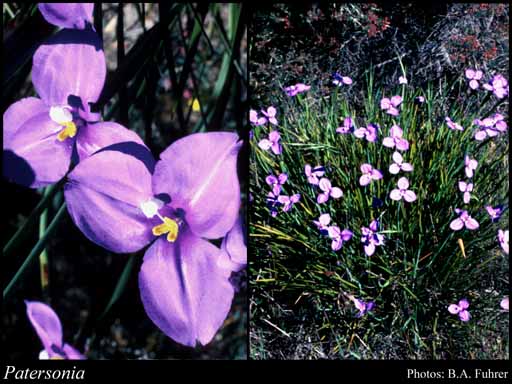- Reference
- Bot.Mag. 26: tab.1041 (1807)
- Name Status
- Current

Scientific Description
Common name. Native irises. Family Iridaceae.
Habit and leaf form. Shrubs (undershrubs, rarely), or herbs; evergreen, or deciduous. Perennial. Leaves basal, or cauline (rarely). Plants with a basal concentration of leaves, or with neither basal nor terminal concentrations of leaves; rhizomatous (perennial, short, woody or rarely corm-like). Helophytic to xerophytic. Leaves alternate; distichous; ‘herbaceous’, or leathery; petiolate (more or less), or subsessile; sheathing. Leaf sheaths with free margins. Leaves foetid, or without marked odour; edgewise to the stem, or with ‘normal’ orientation; simple; epulvinate. Leaf blades entire; flat, or solid; linear, or lanceolate; linear (to ensiform); parallel-veined; without cross-venules; narrowed to a petiole-like base, open or closed sheaths. Leaves eligulate; without stipules. Leaf blade margins entire. Leaves with a persistent basal meristem, and basipetal development. Leaf anatomy. Extra-floral nectaries absent. Stem anatomy. Secondary thickening absent.
Reproductive type, pollination. Fertile flowers hermaphrodite. Unisexual flowers absent. Plants hermaphrodite. Floral nectaries present, or absent. Nectar secretion from the perianth (from nectaries at the tepal bases). Entomophilous, or ornithophilous, or anemophilous.
Inflorescence and flower features. Flowers aggregated in ‘inflorescences’; in cymes (cymose), or in spikes, or in heads (capitate). The terminal inflorescence unit cymose, or racemose. Inflorescences terminal; scape erect, terete, unbranched, leafless, clasped at the base by the innermost leaf or not so; buds enclosed the spathes; inflorescence of 2 rhipidia each with 1–6 flowers, or spikes of few flowers; with involucral bracts (of 2 opposite spathes); spatheate (persistent). Flowers sessile; bracteate (1 subtends each flower, scarious or rigid; shorter narrower bracts separate rhipidia or spikes); bracteolate (1 to each flower, scarious); small to large; regular; 3 merous; cyclic; tetracyclic. Perigone tube present. Free hypanthium more or less included in the bracts, filiform. Perianth of ‘tepals’; 6; 2 -whorled; isomerous; petaloid; without spots, or spotted; similar in the two whorls, or different in the two whorls; white, or yellow, or blue (blue-violet). Androecial members definite in number. Androecium 3. Androecial members adnate; all equal; coherent; when united, 1 - adelphous; 1 -whorled (representing the outer whorl). Androecium exclusively of fertile stamens. Stamens 3; all more or less similar in shape; reduced in number relative to the adjacent perianth to isomerous with the perianth; at the apex of the perianth tube opposite the outer segments; alterniperianthial (opposite the outer perianth lobes). Anthers basifixed; dehiscing via longitudinal slits; extrorse. Gynoecium 3 carpelled. The pistil 3 celled. Gynoecium partly petaloid, or non-petaloid; syncarpous; synstylovarious; inferior. Ovary plurilocular; 3 locular. The ‘odd’ carpel anterior. Gynoecium stylate. Styles 1; apical. Stigmas 3; 3 - lobed. Placentation axile. Ovules 20–50 per locule (many); arillate, or non-arillate; anatropous.
Fruit and seed features. Fruit non-fleshy; dehiscent; a capsule. Capsules loculicidal (from the apex). Fruit 3 celled; 20–100 seeded (many). Seeds endospermic. Endosperm oily. Cotyledons 1 (coleoptile-like). Embryo straight (small). Testa without phytomelan.
Etymology. After William Paterson (1755–1810), commander of the military force in NSW; lieutenant-governor; one of the earliest botanists of the colony and a friend of Robert Brown to whom, and to Sir Joseph Banks, he sent specimens.